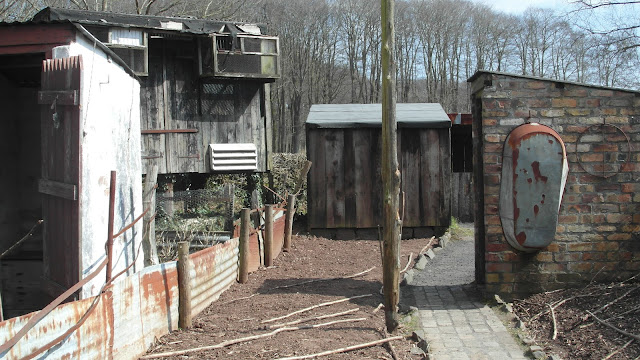I paid a visit to the St Fagans National History Museum near Cardiff, also known as the Museum of Welsh Life.
Since opening in 1948 over 40 historic buildings from across Wales have been dismantled, brought to the museum and re-erected in 100 acre grounds.
You can find out more here: http://www.museumwales.ac.uk/en/stfagans/historic-buildings/
Here are some pictures... (you can click to see them bigger.)
 |
| Kennixton Farmhouse |
The earliest part of this farmhose dates from about 1610. The furnishings are mainly 18th century.
 |
| Beams |
 |
| Irons. |
 |
| Circular stone pig-sty. C 1800. |
 |
| Corn Mill Water-wheel |
 |
| St Teilo's Church |
 |
| Reconstruction of an Iron-Age roundhouse. |
One of my favourite buildings was the Oakdale Workmen's Institute.
 |
| Library at the Oakdale Workmen's Institute |
 |
| Window at Oakdale Workmen's Institute. |
 |
| Upstairs at Gwalia Stores. |
I am reading Pandaemonum 1660 - 1886 by Humphrey Jennings at the moment. The subtitle is 'The coming of the machine as seen by contemporary observers'. It's a collection of first hand accounts, letters, poems and notes from witnesses to the industrial revolution. (The book inspired the opening ceremony of the Olympics). This museum also offers a visual insight into the radical changes that took place during this period and how they affected the way people lived. ...(and live)
A row of 6 ironworkers terraced houses at the museum have been furnished and adapted to show different periods of occupation. They were occupied from 1795 to 1985! More info here: http://www.museumwales.ac.uk/en/stfagans/buildings/rhydycar/
 |
| A plate in the Rhyd-y-car Terrace |
 |
| Mirror in the 1955 Rhyd-y-Car Terrace |
 |
| Yard at Rhyd-y-Car Terrace. |
 |
| Roller-Skates. |
 |
| Anvil at the Smithy. |
 |
| Cilewent Farmhouse. A longhouse which would have housed cattle at one end. |
 |
| Byre-floor. |
 |
| Window - Cilewent Farmhouse. |
 |
| Nant Wallter Cottage - C 1770 |
 |
| A pig enjoying a rare bit of sunshine. |







